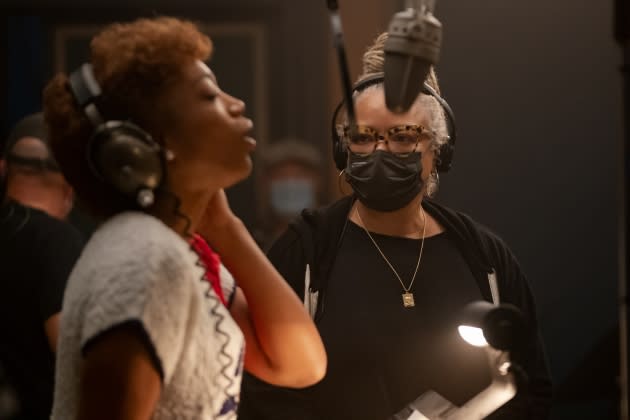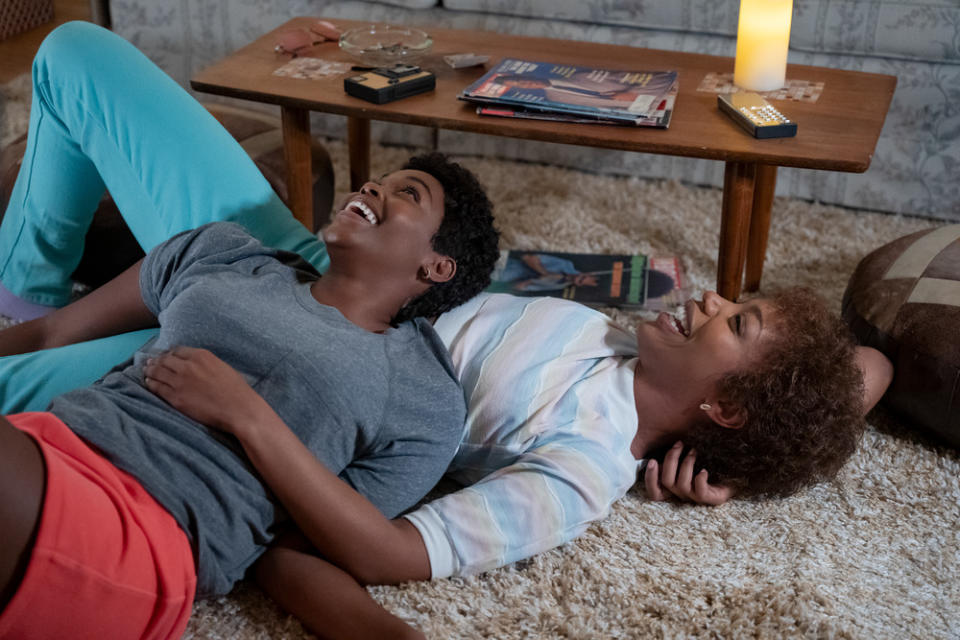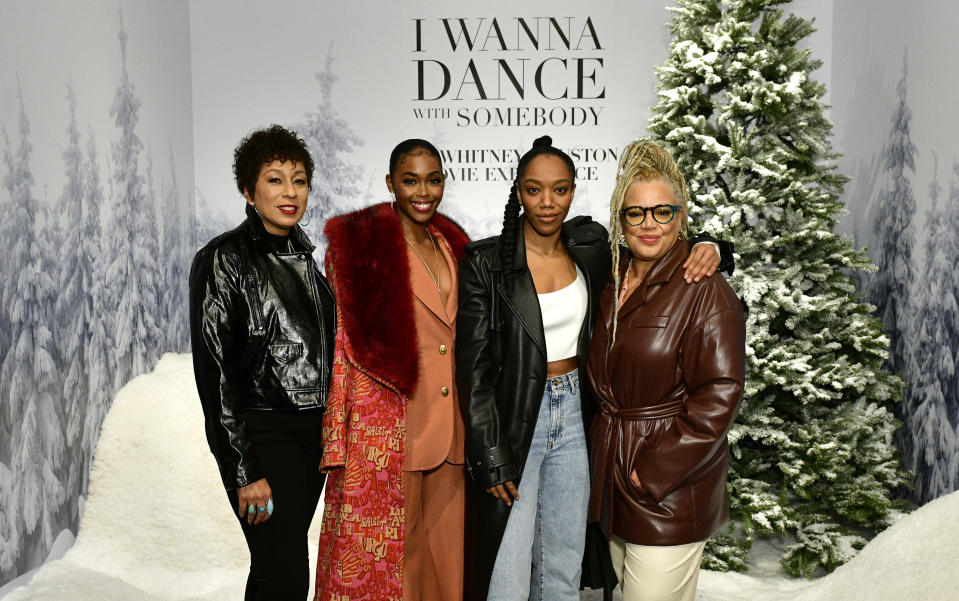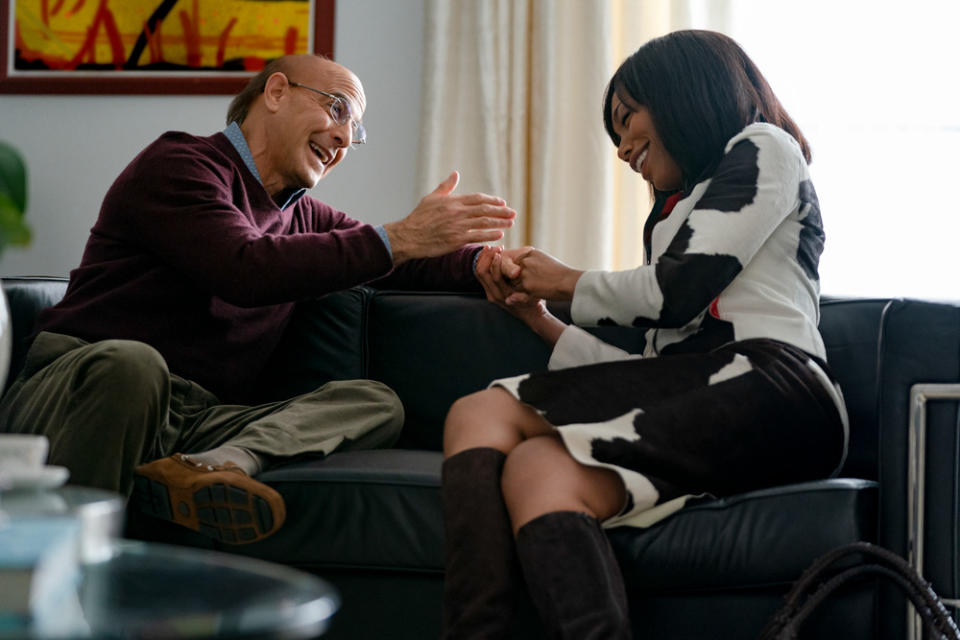Kasi Lemmons’ Battle to Make the Whitney Houston Biopic ‘I Wanna Dance with Somebody’
- Oops!Something went wrong.Please try again later.
- Oops!Something went wrong.Please try again later.
- Oops!Something went wrong.Please try again later.

Kasi Lemmons had quite a few reservations prior to boarding the biopic Whitney Houston: I Wanna Dance with Somebody. For starters, she’d run in similar circles to the iconic musician in the ‘80s and early ‘90s, back when Lemmons was acting in films like School Daze and The Silence of the Lambs. After transitioning to filmmaking with her remarkable debut Eve’s Bayou, she met with Whitney to pitch a screenplay she’d written for her about the International Sweethearts of Rhythm, a trailblazing all-women swing and jazz group in the ‘30s and ‘40s, only to have her imperious father, John Houston, reject that idea and commission another.
“I had to ask myself the question, Maybe you’re the right person? This African American woman kind of acquainted with Whitney — can you be brave to have perspective as well? I had a panic attack for a couple of days and then decided that I wanted to do it,” Lemmons tells me.
More from Rolling Stone
'I Wanna Dance with Somebody' Comes to Praise Whitney Houston, Not to Bury Her
It's All High Notes and High Drama in the New Trailer for the Whitney Houston Biopic
Her Scent Is Your Scent: HSN Unveils 'Signature' Whitney Houston Fragrance
Then, there was the matter of the production itself. Though Lemmons was impressed with Bohemian Rhapsody screenwriter Anthony McCarten’s script, which covered Houston’s life from her early romance with Robyn Crawford (Nafessa Williams) to her musical heights and tragic death, the film had recently parted ways with its director, Stella Meghie, the Whitney Houston estate was calling a lot of the shots, and its team looked, well, a little too white.
So, Lemmons hired Black women for key roles, including Charlese Antoinette Jones as costume designer, Chanda Dancy as composer, and Daysha Broadway as editor.
“I blackened it,” Lemmons says.

But it was star Naomi Ackie’s screen test that served as the deciding factor for Lemmons. In I Wanna Dance with Somebody, Ackie is tasked with portraying “The Voice” as a teenager, a young artist taking the music industry by storm, a reluctant movie star, an unstable addict, a loving mother, and a cultural legend. Along the way, she is mentored by music guru Clive Davis (Stanley Tucci, marvelous), falls for the volatile Bobby Brown (Ashton Sanders), is guided by her singer-mother Cissy (Tamara Tunie), and exploited by her father John (Clarke Peters).
“I tried to look at this like I would Walk the Line — except instead of one love story, there are six love stories,” explains Lemmons. “I approached it as a series of interconnected love stories.”
In a wide-ranging talk with Rolling Stone, Lemmons discussed how she defied the odds to bring her version of Whitney Houston: I Wanna Dance with Somebody to the screen.
How long did it take you to make Whitney Houston: I Wanna Dance with Somebody? It’s quite a herculean task, covering the entire life of a music legend.
A relatively short amount of time for a filmmaker because I came on in prep. I did 16 or 17 months of continuous work, I would say. When I came on the film didn’t have a director. They had parted ways partway through prep with Stella Meghie, who’s still an executive producer on the movie.
That represents another set of obstacles. You’re basically brought in as the savior of this project.
I thought the patient was worth saving for a number of reasons. When I had first heard of the project from Anthony McCarten years before, I was always interested in it. But it gave me extreme pause to come on late, because it was a thing with so many elements. I thought, “This is really daunting.” And then I saw Naomi’s screen test. I wouldn’t have entertained the conversation until I saw who they had attached, and when I saw her screen test I thought, “This is compelling. This can work.” And that was even before she’d begun her deep dive into her preparation. There was something in that screen test that was undeniable.
What was your relationship with Whitney like?
When I first saw her, I was an actress in New York and in comes this Black performer on the circuit. We felt a kinship with her — we’re New York, she’s from New Jersey; we’re actors, she’s a singer. We felt like she was part of our crew, even though we didn’t know her. We were fangirling over this new performer. I was a fan of hers for years, and then my career transformed. I started to become a writer and had written a screenplay that got me other jobs writing screenplays. I was writing a screenplay that everyone involved thought she would be perfect for, so I got a meeting with her and got to pitch to her. In that same meeting, her father cornered me and said, “I don’t know if she’s gonna do that. We will see. Would you write another movie for her?” They pitched me an idea, and I got hired by her company to write another screenplay for her. So, I actually wrote two screenplays for Whitney.
What was that first screenplay you wanted her for—and the role?
The first screenplay was based on the true story of the Sweethearts of Swing — a big swing band in the ‘30s — and she was the bandleader. She was the one who held them together. The second screenplay was an original that was based on a journalism idea that John Houston had, and that I ended up turning into something completely different but still writing it for Whitney. The reason I don’t want to talk about it is because I’m still trying to get the film made. I think I’ve written about fifty screenplays, and it remains one of my favorite, favorite screenplays I’ve ever written. My drafts for that one go way back into the ‘90s.
When the trailer for Whitney Houston: I Wanna Dance with Somebody first dropped, there was some criticism online over Naomi’s appearance compared to Whitney. What would you say to those people?
I think if you have any concern about the way she looks it’s gonna go away within ten minutes of seeing her perform. We all knew that going in. Naomi is very aware she doesn’t look like Whitney, and we all knew there would be rumbles of that. But she captures the essence of Whitney. There’s something about Naomi where it’s natural to her. It’s not like she’s trying for it, it’s a part of her. When I came on, I was grounded by the fact that the estate had chosen her and said, “Yes, she has the essence of Whitney.” The people that knew her most in the movie felt that Naomi had the spark of Whitney, and she continues to. There’s something about Naomi herself that reminds me of Whitney, but to be that good of an actor and to have that kind of work ethic — this meticulous approach to preparation, and to immerse herself utterly in this role — by the time she brings it to the screen, she’s incredible.
There is also the issue of tackling her singing, because you can’t exactly hire an actor who can sing like Whitney. She is one of one.
She sings a lot in the movie, in fact! One of the wonderful things about Naomi is that she sings well enough and in the same range as Whitney that I could have her sing in key — when she’s warming up, when she’s practicing with [bandleader] Rickey Minor — but not when she’s performing as Whitney.

To be completely honest, when I saw that this film was by some of the team behind Bohemian Rhapsody, I was a bit worried. Because that film pretty much erased Freddie Mercury’s gayness and did some very strange things—like retconned his AIDS diagnosis to have him be diagnosed with AIDS prior to its big Live Aid finale for added drama. Had you seen Bohemian Rhapsody and had similar reservations prior to tackling this project?
You know, I had all kinds of reservations. So many reservations. But at the same time, I’d really saw something in the script. I saw that they went places I didn’t think they were going to go. I was compelled by the risks they’d taken in including a lot of truth. And I looked at them as separate movies. This was a woman’s story — a Black woman’s story — and I could help it be the story that I wanted it to be.
When you came onto the project during pre-production, what were the Kasi Lemmons tweaks that you made to it?
Anthony and I worked together really closely [on the script], and he did about eight drafts with me—and he was great to collaborate with. Everything changed. Some really beautiful work had been done, and there was a really talented crew that was in place. I brought some people onto the movie that I think made a huge difference. I brought on a Black woman costume designer [Charlese Antoinette Jones], a Black woman composer [Chanda Dancy], a Black woman editor [Daysha Broadway]. I blackened it. I brought women on in key positions, and this is the first time in a studio movie where you’ve had a Black woman composer, editor, and director. I’m really proud of that. And the approach changed. They were gonna shoot 1:85:1 and I shot in 2:35:1 Anamorphic. And the style. I love Stella’s work, I think she’s great, but we’re very different directors.
What about the story itself? Were you responsible for beefing up the relationship between Whitney Houston and Robyn Crawford?
Yeah. And really looking at all these different love stories. I’m probably more responsible for beefing up the father story, but that was already there too. We were watching the Robyn and Whitney story from my little Black showbiz community. Just observing it. We were very aware of Robyn. Whitney was always with Robyn, and we were aware of Robyn to the point where when she married Bobby, we were like, “Wait… what about Robyn?” And it’s the same thing with John — only I’d met John, and John had hired me to write a script. I got a sense of John, and I was a little shaken by John. He was a very imposing person and talked about “the brand,” and I thought that was spooky.

Casting John Houston as the villain here did make me think of Eve’s Bayou. Obviously, what the father does in that film is more sinister than what John does.
I like to look at them not as “sinister” but as deeply-flawed men. Us directors—we’re always working out something! Daddy issues do come up in my movies sometimes. [Laughs]
Back to the Whitney-Robyn relationship: I’m really glad you included it in the film in a significant way. Why was that so important for you to include? And we do only see them peck each other on the lips, so I’m curious if there was some mandate from the estate to not go further as far as the sexual nature of their relationship.
Well, look — I think the kiss was a lot for them. From their perspective, which I understand, Whitney never admitted to the sexual side of their relationship. It’s really in talking to everybody that knew Whitney, which I did, and reading every single book, including Robyn’s book, and seeing the documentaries, and going through everything that a picture formed that is a very, very striking picture. It was obvious that this was a very, very important relationship to Whitney. She trusted her. I wouldn’t have done the movie if that relationship wasn’t in it.
There are 12 producers on this film and an estate involved. As a filmmaker, what sort of hurdles did that introduce? And did you find yourself fighting for certain things?
Well, sure. It was a negotiation. I knew it would be by the producorial makeup of the group. I had two really strong artistic producers — Denis O’Sullivan and Matt Jackson — and so I had collaborators who were storytellers. And then there were some music producers, which was interesting because we had our eyes on different things in different ways, but there was an intersectionality of our intentions that was pure and true. We wanted it to be respectful, a tribute to her, and a celebration of her life as a singer and as a woman.
What were some story elements that you had to fight for? And what were some they shot down?
They didn’t really shoot down anything. There were some difficult conversations, but ultimately I got to make the movie I wanted to make. I think Robyn was an emotional topic, and drugs were an emotional topic.
What were those conversations with the estate like about Whitney’s descent into drug addiction? Because we do see scenes in the film of her holding drug paraphernalia, but I don’t believe we ever see her actually doing drugs.
Nope. Sometimes we’d get into these arguments and they’d be like, “Hey, relax, we’ve got a PG-13 rating! We can’t show that!” So, it’s gonna be suggestion. But even the suggestion was a conversation. And to me, what really works so well is that scene where she comes to Clive’s bungalow and she’s high, and he’s concerned about her. There were ways of getting the story across with a delicate touch, and I think the delicate touch appealed to me. We negotiated and there are cuts that had more drugs. It was a balancing act that went until the end of the final edit. But I like this cut.

How to handle the Bobby Brown of it all is a difficult subject as well — their relationship and some of the abuse that Bobby inflicted on Whitney.
Well, she hit him too. They both did. The important thing for me was that it was a codependent relationship.
She famously said, “Bobby is my drug.”
Bobby is her drug. It was a codependent relationship, and he did not get Whitney into drugs. The drugs were always there. They were a Whitney thing. He didn’t help, but I think that Bobby got vilified for things that were not his fault. Many people get into codependent relationships that are completely dysfunctional, but they loved each other. She could be herself with him.
Since the film covers so much ground, taking us from her teenage years all the way to the tragic end, what were some of the darlings you had to kill?
There were lots that we couldn’t include in the story itself because it would have just been too long. Once we shot the script, we had a four hour and sixteen minute cut. Just a lot more of the relationships and the music, because that’s what I focused on — and what the script focused on. This is my cut of the movie, and it was a process to arrive to it, but there was one scene of Whitney and her mother. We all loved it and couldn’t include it. It was a sweet scene about Whitney reflecting on her career and her God-given gift.
One of the scenes I enjoyed most in the film is when Whitney is reading sheet music and giving her notes to Rickey Minor on “I Have Nothing.” I feel a lot of music biopics struggle to show an artist’s musical genius, so to speak.
I love that scene so much. That’s one of the things we’re bringing to audiences: a look inside this woman’s genius. It’s not just the voice. We call her “The Voice,” but it’s also the artistry. It’s how she chose a song. It’s how she slowed down the national anthem. It’s how she participated in her genius. The other thing is how she could fit into a moment in time in such a spectacular, masterful way. She controlled that moment where the country is going through something — we’re in a war — and she can take the national anthem and seize that moment in time. Or she can go as the first artist in a free South Africa and match those people and that emotion. That was a really singular talent and I wanted to showcase it.
Lastly, where do you feel the line is between art and exploitation when it comes to biopics?
I think that you have to be careful, because we are carnivorous beings. What is salacious titillates us. So you have to fight that urge and say, “It can also be entertaining to see something inspiring.” “It can also be entertaining to look at a human being as a dimensional person.” And also, it’s easy to forget humanity. That’s something that we can’t do. She was a woman, and she was complex, but she had a lot of love in her life. And she gave a lot of love. She loved her daughter. Even though this story may have a tragic ending, it doesn’t make her a tragic figure. I don’t look at Whitney Houston as a tragic figure. I look at her as an inspiring figure — a beautiful, complex woman who’s so incredibly gifted that it’s as if a God walked among us for a brief period of time.
Best of Rolling Stone

